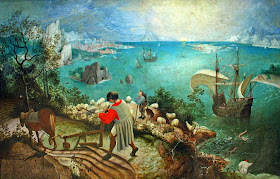 Much of Renaissance art is priceless. If you could own a work by Michelangelo or Botticelli or Raphael you would not only have sublime art to gaze on but could - any time you wanted - sell it for more money than you could hope to spend in a lifetime. And rightfully so. It's not just amazing art. As cliche as it sounds, Renaissance art changed how we looked at the world.
Much of Renaissance art is priceless. If you could own a work by Michelangelo or Botticelli or Raphael you would not only have sublime art to gaze on but could - any time you wanted - sell it for more money than you could hope to spend in a lifetime. And rightfully so. It's not just amazing art. As cliche as it sounds, Renaissance art changed how we looked at the world.And on that note, I think Peter Bruegel's Landscape With The Fall of Icarus from 1555 best depicts the change from focusing on the supernatural to the natural. It shows how the Renaissance changed how we in the west looked at - and saw - the world.
The most obvious thing here is the farmer plowing the land. He's at work. Just behind him is a ship likely laden with goods from or to another land. A shepherd over the shoulder of the farmer is contemplating the sky, perhaps daydreaming or perhaps looking for signs that would help him to forecast the weather. Oh, and in the water before the ship is Icarus who flew too close to the sun.
Icarus's story is amazing. He flew to freedom with wings his father had constructed of feathers and wax. His father warned him not to fly too close to the sun lest the wax melt and the wings be unable to keep him aloft. Of course Icarus was unable to resist the exhilaration of flying high and, indeed, his wings failed him, causing him to fall out of the sky into the sea to his death. Not only are a host of themes bound up in this story of Icarus (among other things he's a lesson in hubris) but the idea of freedom through flight is sort of amazing. Especially to ancient Greeks and even 16th century Dutch.
But what Bruegel does with this incredible story is relegate it to a corner of the painting. Myth has given way to business. The farmer could not be less impressed with Icarus's foolishness.
We can hardly imagine how completely the promise of heaven or threat of hell defined medieval life. For most Europeans from the fall of Rome until the discovery of the new worlds (about a 1,000 years, from roughly 476 to 1492) business concerns like plowing a field were a distant second to religious concerns. By the time of this painting, in more developed places like the Netherlands and Northern Italy, this had begun to shift. And Bruegel's painting rather brilliantly captures this. A great deal of how we look at the world is defined by where we look. By Bruegel's time in the mid-16th century (Columbus had "discovered" the "new" world and Magellan's crew were the first to circle the whole world), people realized that the natural world was full of the unknown, full of promise, full of riches. It deserved our full attention. At least during harvest or planting.


No comments:
Post a Comment